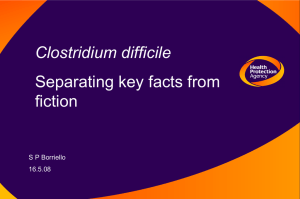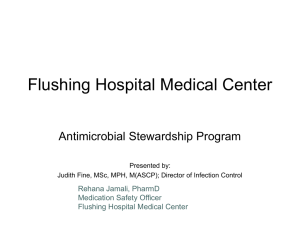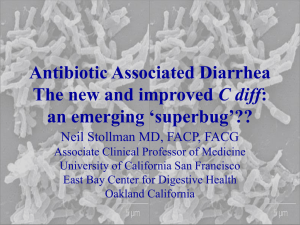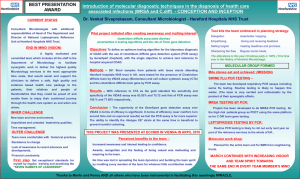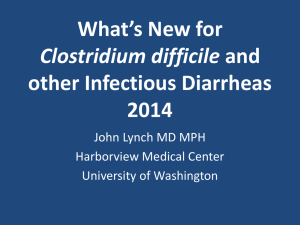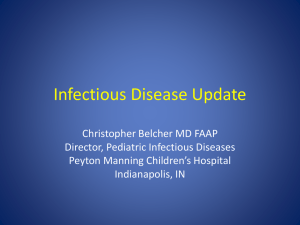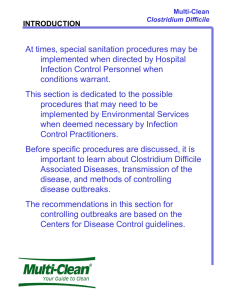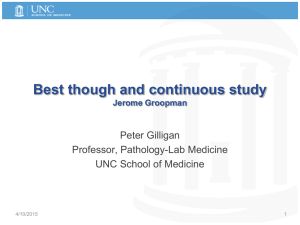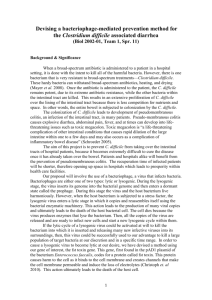Clostridium difficile O27
advertisement
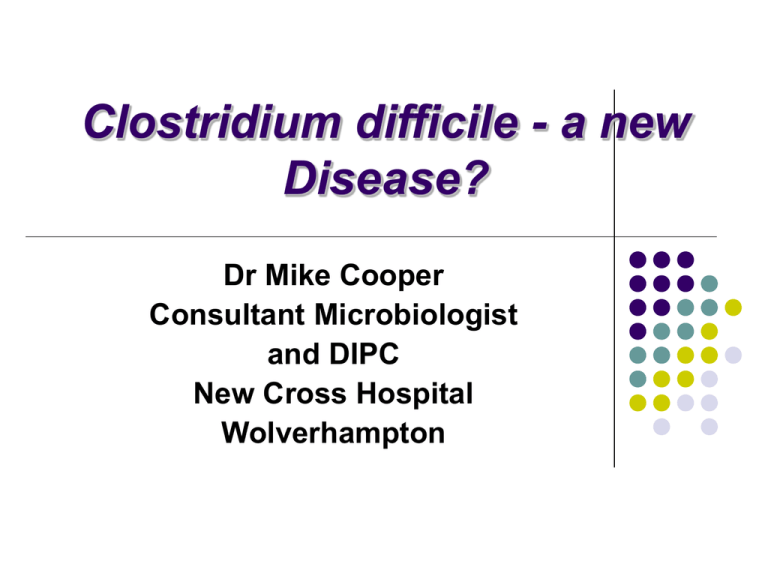
Clostridium difficile - a new Disease? Dr Mike Cooper Consultant Microbiologist and DIPC New Cross Hospital Wolverhampton Oxoid Infection Control Team of the Year Awards – 2006/2007 Winners Announced BASINGSTOKE, UK, 26 April 2007 Oxoid, a world leader in microbiology, is pleased to announce the winners of the 2006/2007 Oxoid Infection Control Team of the Year Awards: 1st Prize: Royal Wolverhampton Hospitals NHS Trust, UK 2nd Prize: Cho Ray Hospital, Vietnam Joint 3rd Prize: Southampton University Hospitals NHS Trust, UK and Aminu Kano Teaching Hospital, Nigeria. C. difficile 1935 - discovered Obligate anaerobe Motile Gram positive bacillus Oval, sub-terminal spores Occasional case reports - infected wounds (1960s) C. difficile 1977 - C. difficile identified as cause Birmingham General Hospital AAD - 20-30% AAC - 50-75% >90% - pseudomembranous colitis C. difficile Toxins Toxigenic strains produce 2 major toxins: toxin A (enterotoxin) toxin B (cytotoxin) Neutralised by C. sordellii antitoxin Toxin A Binds to specific CHO receptors on intestinal epithelium Toxin induced inflammatory process: neutrophils inflammatory mediators fluid secretion altered membrane permeability haemorrhagic necrosis Toxin B Binding site not yet identified Depolymerization of filamentous actin destruction of cell cytoskeleton rounding of cells Clinical Manifestations Asymptomatic carriage (neonates) Diarrhoea 5-10 days after starting antibiotics maybe be 1 day after starting may be up to 10 weeks after stopping may be after single dose spectrum of disease: brief, self limiting cholera-like - 20X/day, watery stool Clinical Manifestations Additional symptoms: Acute toxic megacolon abdominal pain, fever, nausea, malaise, anorexia, hypoalbuminaemia, colonic bleeding, dehydration acute dilatation of colon systemic toxicity signs of obstruction high mortality (64%) Colonic perforation Pathogenesis Disruption of normal colonic flora Colonisation with C. difficile Production of toxin A +/- B Mucosal injury and inflammation Pathogenesis Microflora of gut: Transmission - faecal/oral 1012 bacteria/gram 400-500 species colonisation resistance spores Late log / early stationary phase toxin production Pathology Colonic mucosa - raised yellow / white plaques initially small enlarge and coalesce Inflamed mucosa New C. difficile Toxin Positives in Wolverhampton - Quarterly Totals Community 180 RWHT 160 140 100 80 60 40 20 2007 2006 2005 2004 2003 2002 2001 0 2000 Number 120 New C. difficile Toxin Positives in Wolverhampton - Quarterly Totals Community 180 RWHT 160 140 100 80 60 40 20 2007 2006 2005 2004 2003 2002 2001 0 2000 Number 120 New C. difficile Toxin Positives in Wolverhampton - Quarterly Totals Community 180 RWHT 160 140 100 80 60 40 20 2007 2006 2005 2004 2003 2002 2001 0 2000 Number 120 Mortality All cause 28/7 mortality for CDT positive: 1.12.03 – 31.3.04 18/60 1.12.05 – 31.3.06 71/183 RR 1.29 (CI 0.84 – 1.98) 30.0% 38.8% What Changed? Hand hygiene? Environmental cleanliness? Antimicrobial prescribing? Other factors? What Changed? ?Different organism Independent 6-8th June 2005 PCR Ribotype 027 In North America – PFGE Type NAP1 International = NAP1/027 Major problems in Montreal and several states in the US PCR Ribotype 027 Montreal – 30/7 mortality increased 4.7% in 1991/2 8.6% in 2002 13.8% in 2003 Incidence per 100,000 individuals aged >65 102 (1991-2) 866 (2003) PCR Ribotype 027 First UK isolate – Preston 1999 Second UK isolate – Birmingham 2002 Next seen – March 2004 – Stoke Mandeville Wolverhampton – 8 isolates from Oct – Dec 2005 sent for typing all 027!!! PCR Ribotype 027 North American outbreak strain: 8 to 16 X production of toxins A and B in-vitro Hyper-toxin production: 18bp deletion in the TcdC gene regulates toxin production Strong association with fluoroquinolone use The Lancet 24th Sept 2005: Warny, Pepin, Fang, Killgore, Thompson, Brazier, Frost and McDonald: “Toxin production by an emerging strain of C. difficile associated with outbreaks of severe disease in North America and Europe” RWHT Response Also major problems with MRSA bacteraemias 0.45 Apr-Jun 06 Oct-Dec 05 April-June 05 Oct-Dec 04 April-June 04 Oct-Dec 03 April-June 03 Oct-Dec 02 April-June 02 Oct-Dec 01 April-June 01 Rate per 1000 Bed Days MRSA Bacteraemias RWHT and West Midlands Region RWHT West Midlands 0.4 0.35 0.3 0.25 0.2 0.15 0.1 0.05 0 RWHT MRSA Bacteraemia Statistical Process Control Chart 30 Number of Bacteraemias 25 Total 20 Target 15 Upper Warning Limit Upper Action Limit 10 5 0 AprJune 05 JulySept 05 OctDec 05 JanMar 06 AprJune 06 JulySept 06 OctDec 06 JanMar 07 AprJune 07 JulySept 07 OctDec 07 JanMar 08 RWHT Response DoH MRSA HCAI Improvement Programme Disband ICC Form IPB: chaired by Chief Executive performance management for Divisions and Wards SPCC - C. difficile D17 12 10 C. difficile toxin pos Upper Warning Limit Upper Action Limit 6 Target 4 2 Sep-06 Aug-06 Jul-06 Jun-06 May-06 Apr-06 Mar-06 Feb-06 Jan-06 Dec-05 Nov-05 0 Oct-05 Number 8 RWHT Response to C. difficile Regular commode auditing Replacement of 100 old/damaged commodes Replacement of 300 mattresses Introduction of ‘Saving Lives’ HII Number 6 following every case of CDAD Root cause analysis on every case Introduction of hotel style bed space check lists following discharge of every patient RWHT Response to C. difficile Matron led ward de-clutter programme Introduction of monthly clutter collection 200 domestics trained in CDAD and the role of the environment Medical division nurse training on CDAD, spread and role of equipment Grand Round presentation of case studies and action on CDAD. Mandatory attendance of at least one member of every clinical team. 250 attended RWHT Response to C. difficile ‘Slide card’ for infection prevention for all staff C. difficile management / treatment guidelines New antimicrobial guidelines Antimicrobial prescribing policy Monitoring and antimicrobial prescribing performance management of Divisions Ward refurbishment programme C. difficile – Antibiotic Risk High Risk Antibiotics: Medium Risk Antibiotics: Cefotaxime Ceftriaxone Cefalexin Cefuroxime Ceftazidime Ciprofloxacin Moxifloxacin Clindamycin (low dose) Meropenem Ertapenem Clindamycin (high dose) Co-amoxiclav Tazocin Erythromycin Clarithromycin C. difficile – Antibiotic Risk Low Risk Antibiotics: Benzyl penicillin Amoxicillin Flucloxacillin Tetracyclines Trimethoprim Nitrofurantoin Fusidic acid Rifampicin Gentamicin Metronidazole Vancomycin Teicoplanin Synercid Linezolid Tigecycline Daptomycin Treatment Algorithm For New Cases of C. difficile Diarrhoea Symptomatic Proven or Suspected C. diff infection Assess Patient: AXR, CRP, U& E’s, FBC Stool Chart Stool for C. diff & culture (if not done) Consider Flexi Sig if diagnosis in doubt Review Antibiotics Moderate Disease Well WCC < 20 CRP <150 Normal AXR Severe Disease Unwell WC > 20 * CRP >150 * Abnormal AXR * Distended Abdomen * (* = severe if any of these features) Moderate Start treatment without delay -Metronidazole 400mg TDS for 5 days -Daily Review including stool chart - FBC, CRP, AXR if deteriorates ( If Deteriorates to Severe ) Severe Start treatment without delay -Vancomycin 500mg QDS PO -Metronidazole 500mg TDS IV or 400mg TDS PO - IVI -Consider HDU / ITU Colorectal Surgical Referral on day 1 Daily Surgical Review until improving : if fails to improve consider surgery Response Complete 14 day course of metronidazole No Response :Add Vancomycin 500mg QDS PO for 5 days Complete 14 day course of metronidazole Response Complete 14 day course of Vancomycin Complete course of metronidazole ( If Deteriorates to Severe ) No Response :Refer Gastroenterology for flexible sigmoidoscopy & advice. Continue Vanc & Met Treat as for severe if deteriorates Can be discharged on metronidazole and vancomycin (125mg QDS) Recurrence: ??re-infection Assess: if severe treat as above Moderate: metronidazole 400mg TDS and PO vancomycin 500mg QDS If responds by day 5: 14 days of metronidazole + 500mg QDS vancomycin, then 6 weeks tapering vancomycin If no response after 5 days of combined therapy refer to gastroenterology If remains symptomatic after 10 days and C. diff / PMC confirmed on flexible sigmoidoscopy then consider IV Immunoglobulin. If this is the third or more recurrence then consider immunoglobulin + 2 weeks metronidazole 400mg TDS PO / vancomycin 500mg QDS at the outset followed by 6 weeks of vancomycin. Third Line Drug Regimes for Recurrent Disease:6 weeks Tapering Vancomycin: 125mg every 6 hours for 1 week 125mg every 12 hrs for 1 week 125mg once daily for 1 week 125mg every other day for 1 week 125 mg every 3rd day for 2 weeks IV Immunoglobulin 400mg/kg single dose with a repeat at 21 days if necessary Yeast Yeast preparations are contraindicated. Prebiotic and Probiotics (live yoghurt) No proven benefit of prebiotics or probiotics. Cannot be prescribed and should not be advocated - no quality control over the agents that the patient will receive New C. difficile Toxin Positives in Wolverhampton - Quarterly Totals Community 180 RWHT 160 140 100 80 60 40 20 2007 2006 2005 2004 2003 2002 2001 0 2000 Number 120 New C. difficile Toxin Positives in Wolverhampton - Quarterly Totals Community 180 RWHT 160 140 100 80 60 40 20 2007 2006 2005 2004 2003 2002 2001 0 2000 Number 120 SPCC RWHT C. difficile Toxin Positives 60 50 Upper Action Limit Upper Warning Limit Target 30 RWHT 20 10 Dec-06 Nov-06 Oct-06 Sep-06 Aug-06 Jul-06 Jun-06 May-06 Apr-06 Mar-06 Feb-06 0 Jan-06 Number 40 60 Mar-06 Apr-06 46.73 46.73 41.32 41.32 30.5 30.5 54 57 Commode Audit May-06 46.73 SPCC 41.32 30.5 55 Jun-06 Jul-06 Aug-06 Sep-06 Oct-06 46.73 46.73 46.73 46.73 46.73 RWHT C. difficile Toxin Positives 41.32 41.32 41.32 41.32 41.32 30.5 30.5 30.5 30.5 30.5 25 46 27 18 18 Commode replacement Mattress replacement Nov-06 46.73 41.32 30.5 35 Dec-06 46.73 41.32 30.5 14 Upper Action Limit 50 Grand Round presentation Upper Warning Limit 40 RCA for all c diff cases introduced High Impact Intervention No 6 introduced 30 Target RWHT Bed space checklists introduced 20 Commode re-Audit &feedback Matrons lead Ward Declutter programme Dec-06 Nov-06 Antibiotic review commenced Oct-06 Jul-06 Jun-06 May-06 Apr-06 Mar-06 Feb-06 Jan-06 0 Medical division training Sep-06 Domestics training delivered by IPT Aug-06 10 Dec-07 Nov-07 Oct-07 Sep-07 Aug-07 Jul-07 Jun-07 May-07 Apr-07 Mar-07 Feb-07 Jan-07 Dec-06 Nov-06 Oct-06 Sep-06 Aug-06 Jul-06 Number SPCC RWHT C. difficile 60 50 40 Upper Action Limit Upper Warning Limit Target 30 RWHT 20 10 0 SPCC - C. difficile D17 12 10 C. difficile toxin pos Upper Warning Limit Upper Action Limit 6 Target 4 2 Sep-06 Aug-06 Jul-06 Jun-06 May-06 Apr-06 Mar-06 Feb-06 Jan-06 Dec-05 Nov-05 0 Oct-05 Number 8 Mortality All cause 28/7 mortality for CDT positive: 1.12.03 – 31.3.04 18/60 1.12.05 – 31.3.06 71/183 30.0% 38.8% Mortality All cause 28/7 mortality for CDT positive: 1.12.03 – 31.3.04 18/60 1.12.05 – 31.3.06 71/183 1.12.06 – 31.3.07 23/85 RR 0.70 (CI 0.47 – 1.03) 30.0% 38.8% 27.1% 0.45 Oct-Dec 06 Apr-Jun 06 Oct-Dec 05 April-June 05 Oct-Dec 04 April-June 04 Oct-Dec 03 April-June 03 Oct-Dec 02 April-June 02 Oct-Dec 01 April-June 01 Rate per 1000 Bed Days MRSA Bacteraemias RWHT and West Midlands Region RWHT West Midlands 0.4 0.35 0.3 0.25 0.2 0.15 0.1 0.05 0 MRSA Bacteraemias - Cumulative Numbers RWHT 120 2004/5 100 2005/6 60 2006/7 (actual trajectory) 40 2006/7 (projected trajectory based on total at 6 months) 20 March February January December November October September August July June May 0 April Number 80 Comparison: January 1st - April 23rd 2006 and 2007 250 150 1.1.06-23.4.06 1.1.07-23.4.07 100 MRSA PCT no screens MRSA RWHT no screens MRSA PCT 0 MRSA RWHT 50 New MRSAs Number 200 Jan-Mar 07 70 Oct-Dec 06 Jul-Sep 06 Apr-Jun 06 Jan-Mar 06 Oct-Dec 05 Jul-Sep 05 Apr-Jun 05 Jan-Mar 05 Oct-Dec 04 Jul-Sep 04 Apr-Jun 04 Jan-Mar 04 Oct-Dec 03 Jul-Sep 03 Apr-Jun 03 Jan-Mar 03 Oct-Dec 02 Jul-Sep 02 Number New ESBL Producers in Wolverhampton by Quarter Community Hospital 60 50 40 30 20 10 0 Conclusions New strain(s) of C. difficile cause more severe disease Appear to spread more readily More difficult to control Multi-factorial approach to control needed Requires involvement of entire Trust ??sub-strains not just a medical / nursing solution Not just antibiotics!

